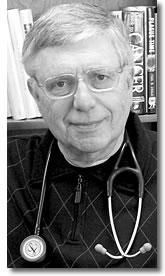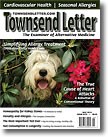|
Page 1, 2, 3
John Trowbridge: What are we trying to accomplish with chelation treatments? If a patient is substantially "loaded" with toxic metals, treatment goals will be different than those for one with high-grade blockage disease in critical arteries. Patients suffering with crippling inflammatory and/or autoimmune diseases might require a another approach.
Injectable and oral medication alternatives to EDTA should be considered, depending on a variety of factors. However, 60 years of beneficial and safe reports regarding EDTA would argue for that to be the basic IV chelator. Others could be added in ways that maximize their safety considerations as well, such as oral DMPS, DMSA, and d-penicillamine, as well as IM DFO.
With different stability constants and side effects, using two or more chelating agents at the same time poses potential risks to the patient. The simplest way to avoid such unpredictable interactions is to administer one chelating drug at a time. In 1993 I developed the idea of administering different chelating drugs on an intermittent, pulsatile schedule. This protocol avoids the potential of interaction of two or more chelation drugs but still allows for exploiting the "preferences" of each drug for different toxic metals. Extra physiologic minerals would, of course, be needed to handle the additional chelator load.
To minimize side effects, I have patients take 1 250 mg tablet each evening during the week. For example, a patient might be advised to take d-pen 250 mg each bedtime on days 1-7 of the month, then DMSA 250 mg each bedtime on days 8-14, then d-pen again on days 15-21 and DMSA again on days 22-28, with a "break" until day 1 of the next month. I do not mix IV EDTA with DFO, nor do I give d-penicillamine or DMSA within 4 to 6 hours of EDTA IV.
With the changing urinary elements test reports, a patient might be told to take just d-pen or DMSA every day of the month. Now that oral DMPS is readily available, it might be inserted into the "weekly" protocol as well, especially when mercury levels are substantially elevated on the test report.
By 1997, I had confirmed that our reduction of toxic heavy metal body burden - as measured by the d-Pen challenge urinary elements test - was proceeding at a rate at least one-third faster than with IV EDTA alone.
Two serious mistakes that beginning doctors often make when giving chelation therapy are insufficient attention to mineral depletion and too rapid reduction of cardiovascular medications. Ample minerals must be supplied, either orally or IV, and gradual reductions of meds are required in order for the body to "relearn" more normal functions.
Conrad Maulfair: With calcium being an important factor in the aging process and in the atherosclerotic disease process, we want to have the maximum benefit from its removal that is possible. I personally am a strong advocate of the 3-4 hour chelation treatment simply based on clinical experience.
Patients suffering from end-stage chronic degenerative diseases are misled when they read or are told that oral application of chelating agents and in particular EDTA can be an alternative to a comprehensive chelation therapy program including the parenteral administration of EDTA. A patient having significant end-stage disease opting to take an oral chelation product because it is cheaper and does not require a personal commitment of time and involvement is most assuredly going to experience a poor outcome. A practitioner who encourages a patient with significant disease to think that using oral chelation is better than doing nothing is being as irresponsible as allowing a patient uncontested to continue to smoke one pack of cigarettes a day because it is better than the two packs a day that he/she had previously smoked.
Garry Gordon: There are many articles and studies that support the use of calcium EDTA. A great number are listed on my website. I have listed 507 abstracts that document the usefulness of oral calcium EDTA to protect lead workers from toxic exposures. Patients who have leaky gut might benefit more from oral EDTA due to enhanced absorption. Blumer and Cranton's classic article that was included in Cranton's textbook showed a 90% reduction in the incidence of cancer for patients with high levels of lead who were treated with intravenous calcium EDTA.
The reported results with IV calcium EDTA for patients with kidney failure and/or diabetes are impressive. This alone should stimulate a flood of research to examine the benefits of calcium EDTA.
Neither author has any conflicts of interest to report.

Notes
1. Lamas G, Goertz C, Boineau R, et al. Design of the Trial to Assess Chelation Therapy (TACT). Am Heart J. 2012 January;163:7-12.
2. Lamas GA, Goertz C, Boineau R, et al. Effect of disodium EDTA chelation regimen on cardiovascular events in patients with previous myocardial infarction: the TACT randomized trial. JAMA. 2013;309:1241-1250.
3. Rozema TC. Special issue: protocols for chelation therapy. J Adv Med 1997;10;5-100.
4. Roussel AM, Hininger-Favier I, Waters RS, Osman M, Fernholz K, Anderson R. EDTA chelation therapy, without added vitamin C, decreases oxidative DNA damage and lipid peroxidation. Altern Med Rev. 2009 Mar;14(1):56-61.
5. Chappell LT, Stahl JP. The correlation between EDTA chelation therapy and improvement in cardiovascular function: a meta-analysis. J Adv Med. 1993;6:139-63.
6. Olszewer E, Carter JP. EDTA chelation therapy in chronic degenerative disease. Med Hypotheses. 1988;27:41-49.
7. Chappell LT, Stahl JP, and Evens R. EDTA chelation treatment for vascular disease: a meta-analysis using unpublished data. J Adv Med 1994;7:131-142.
8. Born GR, Geurkink TL. Improved peripheral vascular function with low dose intravenous ethylene diamine tetraacetic acid (EDTA). Townsend Lett. 1994;July:722-726.
9. Chappell LT, Shukla R, Yang J, Blaha R, et al. Subsequent cardiac and stroke events in patients with known vascular disease treated with EDTA chelation therapy: a retrospective study. Evid Based Integrative Med. 2005;2:27-35.
10. Wilder LW et al. Mobilization of atherosclerotic plaque calcium with EDTA utilizing the isolation-perfusion. Surgery. November 1962;52.
11. Blaurock-Busch E. Toxic Metals and Antidotes: The Chelation Therapy Handbook. Germany: MTM Publishing; 2010.
12. Cranton EM, ed. A Textbook on EDTA Chelation Therapy. 2nd ed. Charlottesville, VA: Hampton Roads; 1989, 2001.
13. Van der Schaar PJ et al. Clinical Metal Toxicology. 10th ed. Leende, Netherlands: International Board of Clinical Metal Toxicology; 2010.
14. Olmstead SF. A Critical Review of EDTA Chelation Therapy in the Treatment of Occlusive Vascular Disease. Klamath Falls, OR: Merle West Medical Center Foundation; 1998.
15. Halstead BW, Rozema TC. The Scientific Basis of EDTA Chelation Therapy. 2nd ed. Landrum, SC: TRC Publishing; 1997.
16. Heistad DD. Unstable coronary plaques. N Engl J Med. 2003;349:2285-2288.
17. Chappell LT, Angus RC and associates. Brachial artery stiffness testing as an outcome measurement for EDTA-treated patients with vascular disease. Clinical Prac Alt Med. 2000;1:225-229.
18. Cranton EM, Frackelton JP. Free radical pathology in age-associated diseases: treatment with EDTA chelation, nutrition, and anti-oxidants. J Hol Med. 1984;6;6-37.
19. Zucker MB, Grant RA. Nonreversible loss of platelet aggregability induced by calcium deprivation. Blood. 1978;52:505-513.
20. Chappell LT. Should EDTA chelation therapy be used instead of long-term clopidogrel plus aspirin to treat patients at risk from drug-eluting stents? Altern Med Rev. 2007;12:152-158.
21. Selye H. Calciphylaxis. Chicago: University of Chicago Press; 1962.
22. Rudolph CJ, McDonagh EW. Effect of EDTA chelation and supportive multivitamin/mineral supplementation on carotid circulation: case report. J Adv Med. 1990;3:5-12.
23. Rubin M. Magnesium EDTA chelation. In: Messerli FH, ed. Cardiovascular Drug Therapy. WB Saunders Co, Philadelphia. 1996.
24. Barbosa F, Sertorio JTC, Garlach RF, Tanus-Santos JE. Clinical evidence for lead-induced inhibition of nitric oxide formation. Arch Toxicol. 2006;80:811-816.
25. Rheaume-Bleue K. Vitamin K2 and the Calcium Paradox. Mississauga, ON: John Wiley & Sons Canada Ltd; 2012.
26. Ellithorpe R. Comparison of the absorption, brain, and prostate distribution, and elimination of CaNa2EDTA of rectal chelation suppositories to intravenous administration. JANA. 2007;10:38-44.
27. Lin JL, Lin-Tan DT, Hsu KH, et al. Environmental lead exposure and progression of renal diseases in patients without diabetes. N Engl J Med. 2003;348:277-286.
28. Chen Kuan-Hsing and associates. Effect of chelation therapy on progressive diabetic nephropathy in patients with type 2 diabetes and high-normal body lead burdens. Am J Kidney Dis. 2012;60:530-538.
29. Nash D, Magler L, Lustberg M, et al. Blood lead, blood pressure, and hypertension in perimenopausal and postmenopausal women. JAMA. 2003;289:1523-1532.
30. Lowe GD and associates. Blood viscosity and risk of cardiovascular events: the Edinburgh Artery Study. Br J Haematol. 1997;96:168-173.
31. Cranton EM. Oral chelation with EDTA is unproven and potentially dangerous [online article]. drcranton.com/chelation/oralchelation.htm. Accessed Dec 30, 2013.
32. Born T, Kontoghiorghe CN, Spyrou A, Kolnagou A, Kontoghiorghes GJ. EDTA chelation reappraisal following new clinical trials and regular use in millions of patients: review of preliminary findings and risk/benefit assessment. Toxicol Mech Methods. 2013 Jan;23:11-17.
33. Chen Q, Espey MG, Krishna MC, et al. Pharmacologic ascorbic acid concentrations selectively kill cancer cells: action as a pro-drug to deliver hydrogen peroxide to tissues. Proc Natl Acad Sci U S A. 2005 Sep 20;102:13604-13609.
34. Chen Q, Espey MG, Sun AY, et al. Ascorbate in pharmacologic concentrations selectively generates ascorbate radical and hydrogen peroxide in extracellular fluid in vivo. Proc Natl Acad Sci U S A. 2007 May 22;104:8749-8754.
35. Levine M, Conry-Cantilena C, Wang Y, et al. Vitamin C pharmacokinetics in healthy volunteers: evidence for a recommended dietary allowance. Proc Natl Acad Sci U S A. 1996 Apr 16;93:3704-3709.
36. Padayatty SJ, Levine M. New insights into the physiology and pharmacology of vitamin C. CMAJ. 2001 Feb 6;164:353-355.
37. Padayatty SJ, Sun H, Wang Y, et al. Vitamin C pharmacokinetics: implications for oral and intravenous use. Ann Intern Med. 2004 Apr 6;140:533-537.
38. Chen P, Stone J, Sullivan G, Drisko J, Chen Q. Anti-cancer effect of pharmacologic ascorbate and its interaction with supplementary parenteral glutathione in preclinical cancer models. Free Radic Biol Med. 2011 Aug 1;51:681-687.
39. Chelation therapy reduces cardiovascular events for older patients with diabetes [online press release]. National Center for Complementary and Alternative Medicine. http://nccam.nih.gov/news/2013/111913?nav=gsa, accessed 12/30/2013.
40. Chen Q, Espey MG, Sun AY, et al. Pharmacologic doses of ascorbate act as a prooxidant and decrease growth of aggressive tumor xenografts in mice. Proc Natl Acad Sci U S A. 2008 Aug 12;105:11105-11109.
41. Kositsawat J, Freeman VL. Vitamin C and A1c relationship in the National Health and Nutrition Examination Survey (NHANES) 2003-2006. J Am Coll Nutr. 2011 Dec;30:477-483.
42. Alberg A. The influence of cigarette smoking on circulating concentrations of antioxidant micronutrients. Toxicology. 2002 Nov 15;180:121-137.
43. Ambrose J, Barua RS. The pathophysiology of cigarette smoking and cardiovascular disease: an update. J Am Coll Cardiol. 2004 May 19;43:1731-1737.
44. Northrop-Clewes C, Thurnham DI. Monitoring micronutrients in cigarette smokers. Clin Chem Acta. 2007 Feb;377(1-2):14-38.
45. Schindler TH, Nitzsche EU, Munzel T, et al. Coronary vasoregulation in patients with various risk factors in response to cold pressor testing. J Am Coll Cardiol. 2003 Sep;42:814-822.
46. Arnson Y, Shoenfeld Y, Amital H. Effects of tobacco smoke on immunity, inflammation and autoimmunity. J Autoimmun. 2010 May;34:J258-J265.
47. Miller WL, Auchus RJ. The molecular biology, biochemistry, and physiology of human steroidogenesis and its disorders. Endocr Rev. 2011 Feb;32:81-151
48. Padayatty SJ, Doppman JL, Chang R, et al. Human adrenal glands secrete vitamin C in response to adrenocorticotrophic hormone. Am J Clin Nutr. 2007 Jul;86:145-9.
49. Suh S-Y, Bae WK, Ahn H-Y, Choi S-E, Jung G-C, Yeom CH. Intravenous vitamin C administration reduces fatigue in office workers: a double-blind randomized controlled trial. Nutr J. 2012 Jan;11:7.
50. Bruno RM, Daghini E, Ghiadoni L, et al. Effect of acute administration of vitamin C on muscle sympathetic activity, cardiac sympathovagal balance, and baroreflex sensitivity in hypertensive patients. Am J Clin Nutr. 2012 Aug;96:302-308.
L. Terry Chappell, MD, is in private family practice in Bluffton, Ohio. He has served as president of ACAM and ICIM and was an investigator for TACT.
 Jeanne A. Drisko, MD, CNS, is the Hugh D. Riordan Endowed Professor of Orthomolecular Medicine and director, KU Integrative Medicine at the University of Kansas Medical Center. Dr. Drisko started KU Integrative Medicine at the request of the dean of the School of Medicine in 1998. KU Integrative Medicine has flourished and includes the four pillars of the academic institution to include patient care, research, teaching, and service. She also served as president of ACAM and as an investigator for TACT. Jeanne A. Drisko, MD, CNS, is the Hugh D. Riordan Endowed Professor of Orthomolecular Medicine and director, KU Integrative Medicine at the University of Kansas Medical Center. Dr. Drisko started KU Integrative Medicine at the request of the dean of the School of Medicine in 1998. KU Integrative Medicine has flourished and includes the four pillars of the academic institution to include patient care, research, teaching, and service. She also served as president of ACAM and as an investigator for TACT.
Corresponding Author
Dr. Jeanne Drisko
jdrisko@kumc.edu
913-945-6607
913-588-0012 (fax)
Page 1, 2, 3
|
![]()
![]()
![]()






 Jeanne A. Drisko, MD, CNS, is the Hugh D. Riordan Endowed Professor of Orthomolecular Medicine and director, KU Integrative Medicine at the University of Kansas Medical Center. Dr. Drisko started KU Integrative Medicine at the request of the dean of the School of Medicine in 1998. KU Integrative Medicine has flourished and includes the four pillars of the academic institution to include patient care, research, teaching, and service. She also served as president of ACAM and as an investigator for TACT.
Jeanne A. Drisko, MD, CNS, is the Hugh D. Riordan Endowed Professor of Orthomolecular Medicine and director, KU Integrative Medicine at the University of Kansas Medical Center. Dr. Drisko started KU Integrative Medicine at the request of the dean of the School of Medicine in 1998. KU Integrative Medicine has flourished and includes the four pillars of the academic institution to include patient care, research, teaching, and service. She also served as president of ACAM and as an investigator for TACT.